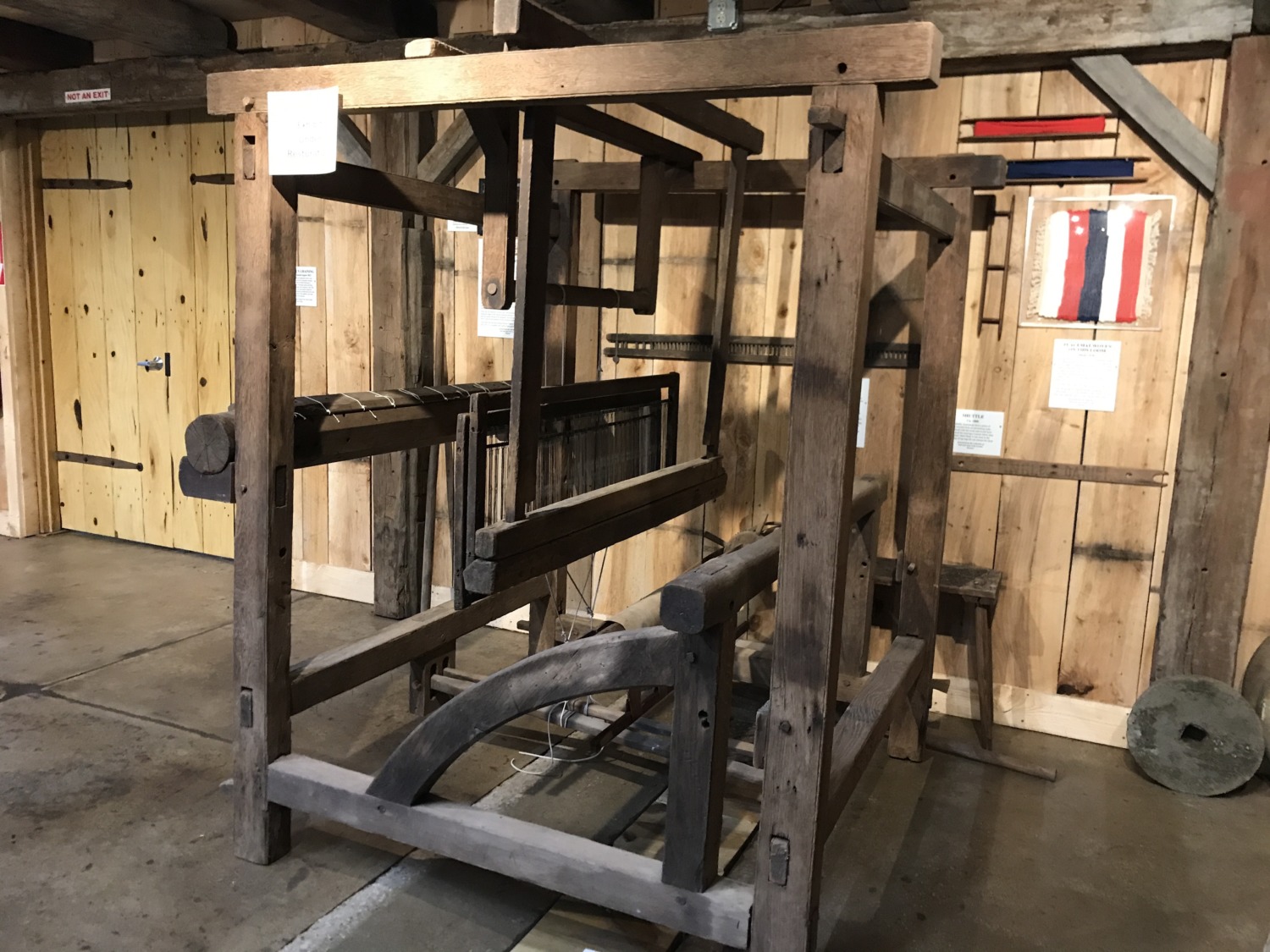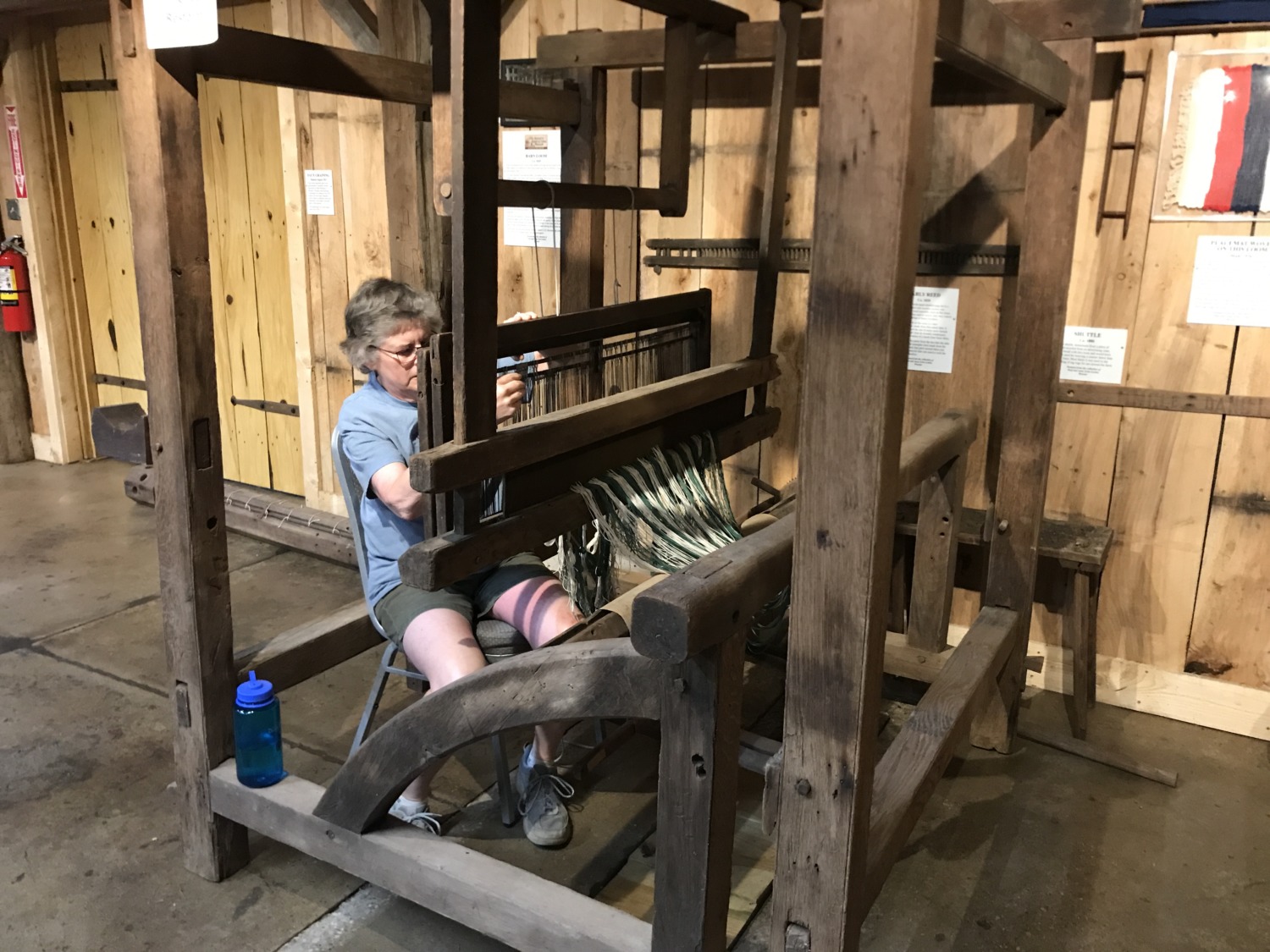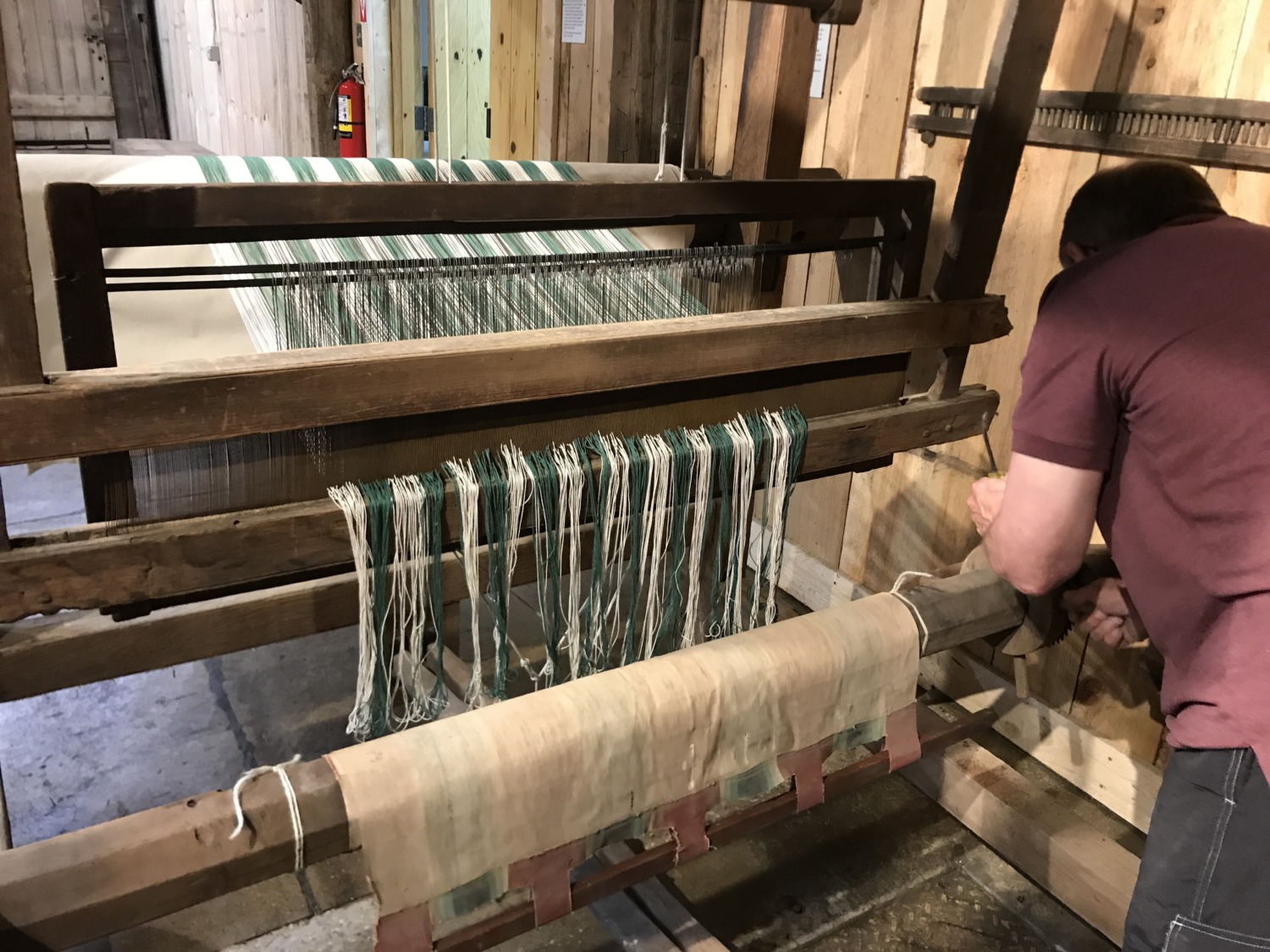I recently spent a couple of days warping the old barn loom at the Buckeye Agricultural Museum in Wooster. The Buckeye Agricultural Museum is a dream that my Uncle Paul shared with my Grandpa Irvin. After Grandpa’s death, Uncle Paul made it a reality, opening the museum in 2018. We have visited several times and each time the museum has expanded and has more items on display.
Last year Uncle Paul and a group of volunteers reconstructed an old barn inside one part of the museum. This large area now holds the barn, lots of farm machinery, and an old barn loom. Uncle Paul bought the barn loom years ago at an auction. The auctioneer knows Paul, and when no one else bid on it, Paul agreed to pay $20 to haul it away. Because it is a barn loom, it is large and very heavy.

Barn looms were early American looms that had a shape similar to the framing of a barn. A barn loom is typically 8 feet by 8 feet in width and depth and 8 feet tall. This outside frame was too large to keep in a house, so it was typically housed in the barn or an outdoor shed. Most of these large looms were made by farmers so that their wives could weave plain cloth or rugs on their homesteads. Many of them only have two shafts, but some have four. The harness that holds the shafts and the batten which beats the cloth, hang from the large frame. They are very sturdy looms and can last a long time.
Once Uncle Paul had a place to put the loom, he had to figure out how to get it together. He is not particularly familiar with looms, so he asked Tom and I to come and look at it. Paul had it together, but the shafts were not moving up and down. When he told us that, Tom and I suspected that the problem was simply tying the shafts to the treadles. We headed over to the Buckeye Agricultural museum one day last November and had it put together in no time.

As we suspected, the loom was missing the ropes that held up the shafts and tied them to the treadles. Tom added these and we made sure they worked. I asked Uncle Paul if he would like to have the loom warped, so people could see how it worked, and he eagerly agreed. Because of time constraints, I was not able to warp it in the fall, but by June I had the warp measured and ready to put on the loom.
I had thought about warping the loom so that we could make some plain cloth towels, but Uncle Paul only had rag shuttles. He had seen some women weaving on this loom in 1976 at a Wayne County Bicentennial Celebration. They were weaving placemats, and he has a sample of what they were weaving next to the loom. The rag shuttles, however, limited what we could display unless we got him some other shuttles. Tom rooted around in some antique stores but we couldn’t find any antique shuttles.
Although the barn loom is roughly from the 1830’s, the heddles (what the strings go through) are more recent metal additions. Heddles from the 1830’s would have been string. After realizing that the only thing I could weave with a rag shuttle was a rag rug, I asked Uncle Paul how wide the reed was and how many heddles there were. He told me the reed was about 18″ wide and there were two heddles. He meant there were two shafts. And his reed was closer to 48″ wide. I knew the reed had 15 dents (holes) per inch, so that gave me a starting place. Not knowing how wide the rag rug could be, I prepared 600 strings to make a rag rug that would be 36″ wide.

When we got to the Buckeye museum, I asked Paul and Tom to count the heddles so I could know how many strings I could use. It turns out there were a little over 400 heddles. That meant I could weave something that was a little less than 27 inches wide (27×15=405). I started sleying the reed (weaving has such a wonderful and specific vocabulary) while Tom made sure the rest of the loom was operable. It takes a while to put 400 threads through 400 spaces on a reed.
When the reed was threaded, Tom and I put it on the loom and I started threading the heddles. Again, each thread has to go through the eye of one of the heddles. This is tedious work. I enjoy it, but it takes a while and can’t be rushed. By the time we had finished these two steps, I had been at the loom for five hours and was getting tired. We decided to break for the day and come back the following week to finish up.

I thought we would be able to come back and, in a couple of hours, I would be done. Of course, nothing ever works quite as smoothly as we expect it to. Tom and I started by tying the ends onto the warping beam at the back of the loom. This doesn’t take long because we could tie the threads in groups. Then, with Aunt Anne’s help, we started winding on the back beam. Tom turned the huge beam, while Anne and I tried to keep the yarn from tangling at the front of the loom.
When that task was completely, all we had to do was tie the threads on to the front cloth beam. It should have been easy. But the front beam wouldn’t turn. Something was caught in it and prevented it from turning. Tom felt in the hole where the front beam was placed and found out that some parts had come off the beam and were acting as stops to keep the beam from turning. He was able to get several pieces out quickly, but one larger piece eluded him. He tried reaching it. I tried reaching it. We could feel it, but it wouldn’t come out. Tom bent a coat hanger. We tried pliers. Finally, after he had been at it close to an hour, we all agreed to go to lunch and come back at it when we were refueled.

After lunch, Tom went back at the wedge in the beam. After another 45 minutes, we decided the only thing to do was drill a hole in the post holding the beam and get the piece of wood out that way. Uncle Paul had his drill ready to go when we all decided that Paul had not tried to get the piece of wood out yet. Tom’s fingers were too short. Mine were too short. But Paul is tall and has long fingers. Maybe he could succeed. And, indeed, just a minute later he had the piece of wood out of the hole! There was much rejoicing and clapping.

With the cloth beam now working as it should, Tom and I started tying on the cloth beam. After a few more adjustments, we had the cloth beam ready to go. I tried pushing down a treadle to raise the shed and – nothing. The back warp beam was so high that the top of the shed wouldn’t rise enough to let me pass the shuttle through. There was only one thing to do: rewind the warp beam the other direction. Tom, Anne, and I worked together and soon had it rewound, although it wasn’t as beautiful as it was when we wound it the first time. But, at least, the shafts were moving properly.
Now another problem arose. The threads were not moving smoothly in the reed. The reed was made of steel and it had rusted. Paul spent hours sanding the reed but it was still pretty rough. At this point I was tired of figuring out how to solve all these problems. The warped loom looked good, even if we couldn’t weave on it. I decided to run the rag shuttle back and forth a few times to give the suggestion of weaving, even if I had to clear a space for the shuttle each time. But, after a few times with the shuttle going back and forth, the threads started moving more smoothly through the reed.
I thought about starting some “real” weaving – as I would have started a rag rug at home – but it was 3 p.m. and we were all tired of gathering around the loom. My parents had waited very patiently all day for something I told them would only take a couple of hours. I’m sure Anne and Paul had other things they wanted to do with their day. We all gathered around the loom and decided that it looked good enough. People would be able to get the idea of weaving by looking at what we had done.
I may decide, at some future point, to go back and start a real rag rug on the barn loom. For now, I’m just glad to get the warping done. The loom is warped and ready to go. It just goes to show that working with old things can make old people tired!
